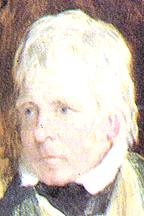|
|
Ⅳ. The English Novel of the Age
1. Walter Scott and Historical Novels
Life
 Walter Scott was born in Edinburgh, as the son of a solicitor Walter Scott
and Anne, a daughter of professor of medicine. An early illness - polio -
left him lame in the right leg. Six of his 11 brothers and sisters died in
infancy. However, Scott grew up to be a man over six feet and great physical
endurance.
Walter Scott was born in Edinburgh, as the son of a solicitor Walter Scott
and Anne, a daughter of professor of medicine. An early illness - polio -
left him lame in the right leg. Six of his 11 brothers and sisters died in
infancy. However, Scott grew up to be a man over six feet and great physical
endurance.
Scott spent his early years in Sandy-Know, in the residence
of his paternal grandfather. There his grandmother told him tales of old
heroes. At the age of eight he returned to Edinburgh. He attended Edinburgh
High School (1779-1783) and studied at Edinburgh University arts and law
(1783-86, 1789-92). At the age of sixteen he had already started to collect
old ballads and later translated into English
Gottfried Bürger’s ballads
The Wild Huntsman, Lenore and Goetz of Berlichingen (1799) from
Johann
Wolfgang von Goethe’s play. Scott was apprenticed to his father in 1786 and
in 1792 he was called to the bar. In 1799 he was appointed sheriff depute of
the county of Selkirk. After an unsuccessful love affair with Williamina
Belsches of Fettercairn -- she married Sir William Forbes -- Scott married
in 1797 Margaret Charlotte Charpentier (or Charpenter), daughter of Jean
Charpentier of Lyon in France. They had five children.
In 1806 Scott became clerk to the Court of Session in Edinburgh - this work
took only a few hours daily and half of the year he was free. His long
holidays Scott spent at Ashestiel, situated on the Tweed River. To increase
his income he started a printing and publishing business with his friend
James Ballantyne. The firm had in the 1810s financial difficulties, and
Scott spent his time in immense labours for his publishers, much of it hack
editorial work. Scott also expanded his Abbotsford estate during these
years, but it was not until 1826 when the final crash came. He accepted all
Ballantyne’s debts and decided to pay them off with his writings -- the sum
was £130,000.
In the 1810s Scott published several novels anonymously or under the
pseudonym Jebediah Cleisbotham or “Author of Waverley”. From this period
date such works as Waverley (1814), dealing with the rebellion of 1745,
which attempted to restore a Scottish family to the British throne. The book
set the classic pattern of the historical novel. It had a hero, whose
loyalty is split between two rulers and two ways of life. Scott continued
with Guy Mannering (1815) and Tales of My Landlord (1816), consisting of
The Black Dwarf and Old Mortality. Rob Roy (1817) was a portrait of one of
Scotland’s greatest heroes - the novel sold out its edition of 10, 000
copies in two weeks. The Heart of Midlothian (1818) was a story of Jeanie
Deans’ journey to London to appeal on behalf of her sister who has been
wrongfully charged with child murder. The Bride of Lammermoor (1819) was a
novel of loss, love and vengeance, a venture into the gothic genre. In A
Legend of Montrose (1819) Scott drew a picture of the campaigns of 1644.
Ivanhoe (1819) was set in the reign of Richard I and depicted the rivalry
between the King and his wicked brother John (King 1199-1216).
In 1820 Scott was created a baronet. A few years later he founded the
Bannatyne Club, which published old Scottish documents. Scott visited France
in 1826 to collect materials for his Life of Napoleon, which was published
in 9 volumes in 1827. A few years earlier Scott had started to keep his
Journal, recording in undiscourageable spirit his deteriorating health and
other misfortunes. His wife, Lady Scott, died in 1826, and the author
himself had a stroke in 1830. Next year Scott sailed to Italy. In Malta he
wrote one novel and a short story, and in Naples he collected old songs and
ballads. After return to England in 1832, he died on September 21. Scott was
buried beside his ancestors in Dryburgh Abbey. From the profits of his
writings all his debts were ultimately paid.

|
![]()
![]()